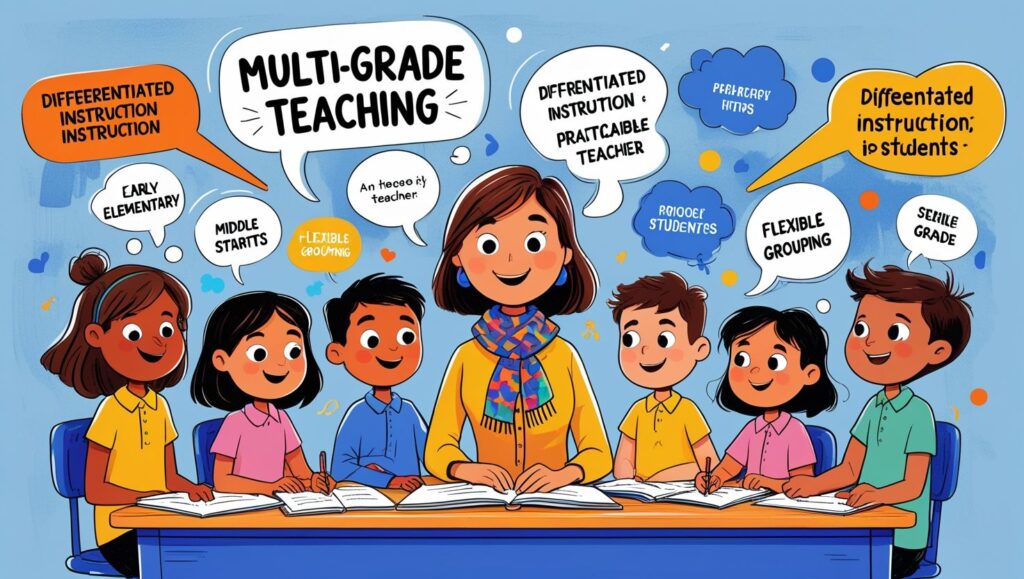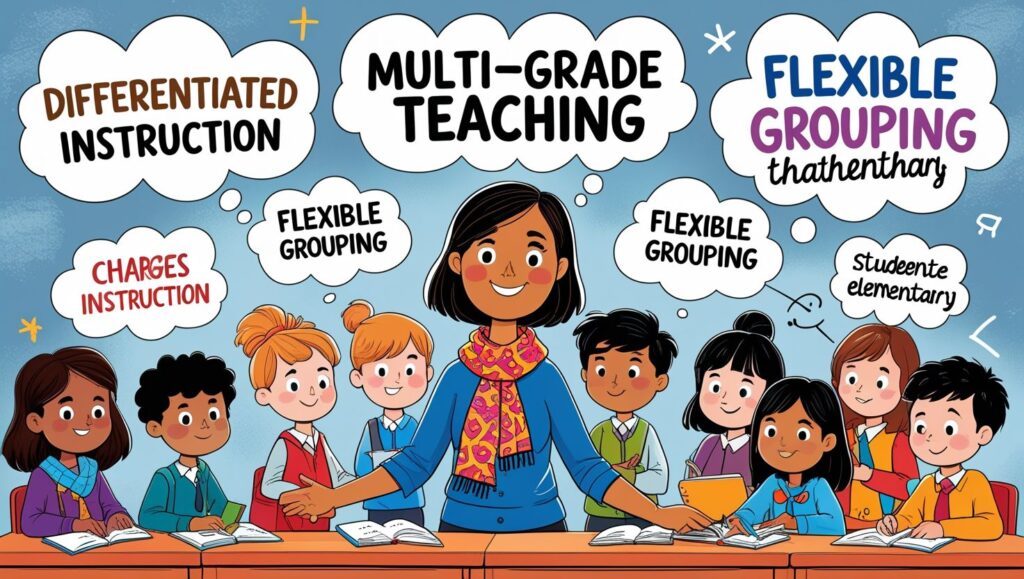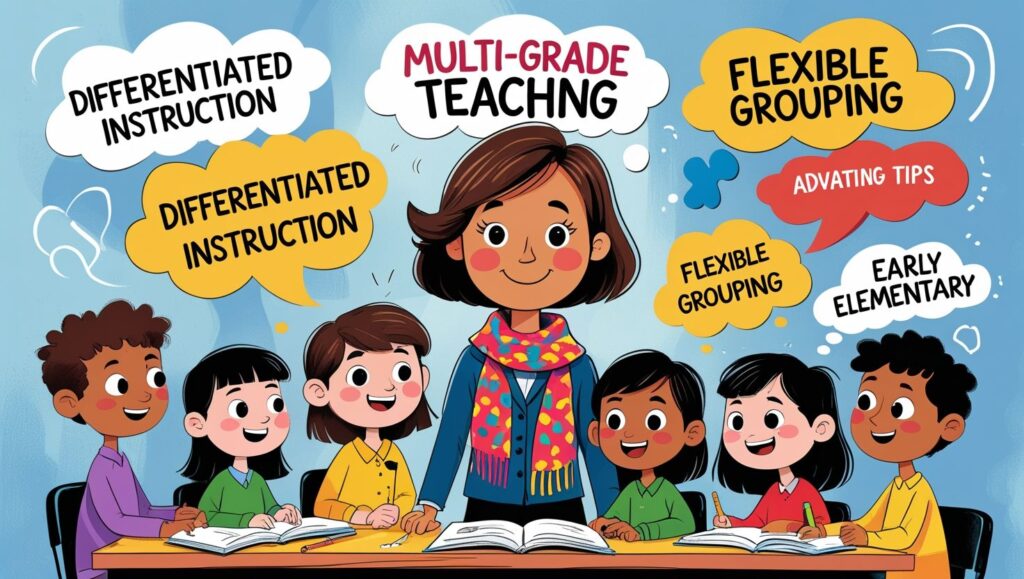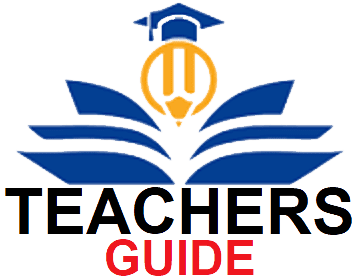Introduction
Multi-Grade Teaching in Primary Schools, Multi-grade teaching is an educational approach where a single teacher instructs students from multiple grade levels simultaneously within the same classroom. This method is commonly practiced in rural and remote primary schools where student enrollment is low, and resources are limited. While multi-grade teaching presents unique challenges, it also offers several benefits, including personalized learning, peer mentoring, and enhanced social skills among students.
This article explores the concept of multi-grade teaching, its historical background, strategies for effective implementation, challenges faced by teachers, and the advantages it offers in primary education.
Historical Background of Multi-Grade Teaching
Multi-grade teaching is not a new phenomenon. In the 19th and early 20th centuries, one-room schoolhouses were common in rural areas across Europe, North America, and other parts of the world. A single teacher would educate children of different ages and abilities in the same classroom due to limited infrastructure and low population density.
With the expansion of formal education systems, many countries transitioned to single-grade classrooms. However, multi-grade teaching remains prevalent in developing nations and remote regions where schools cannot justify separate classrooms for each grade due to small student numbers.

Understanding Multi-Grade Teaching
Multi-grade classrooms consist of students from two or more grade levels learning together under one teacher. Unlike traditional single-grade classrooms, multi-grade teaching requires flexible instructional strategies to cater to diverse learning needs.
Key Characteristics of Multi-Grade Teaching:
- Combined Curriculum: Teachers integrate learning objectives from different grades, allowing students to progress at their own pace.
- Peer Learning: Older students assist younger ones, reinforcing their own knowledge while helping others.
- Differentiated Instruction: Lessons are adapted to suit varying academic levels within the same class.
- Collaborative Learning: Group activities encourage interaction among students of different ages.
Strategies for Effective Multi-Grade Teaching
To ensure successful multi-grade teaching, educators must adopt specialized strategies that address the diverse needs of students. Below are some effective approaches:
1. Flexible Lesson Planning
Teachers should design lessons that incorporate activities for different grade levels. For example, a reading lesson may include:
- Grade 1: Letter recognition and phonics
- Grade 2: Simple sentence formation
- Grade 3: Reading comprehension exercises
2. Peer Tutoring and Cooperative Learning
Encouraging older students to mentor younger ones fosters a collaborative learning environment. This not only reinforces knowledge for older students but also provides individualized support for younger learners.
3. Use of Learning Centers
Setting up different learning stations allows students to engage in grade-appropriate tasks independently. For instance:
- Math Center: Basic counting for Grade 1, multiplication for Grade 2
- Reading Corner: Picture books for younger students, chapter books for older ones
4. Differentiated Assignments
Teachers should assign tasks based on each student’s ability rather than strictly by grade. This ensures that all learners are challenged appropriately.
5. Integrated Thematic Teaching
Combining subjects under a common theme (e.g., “The Environment”) allows students of different grades to explore topics at their own level while participating in shared discussions.
6. Rotational Grouping
Dividing the class into small groups and rotating them between teacher-led instruction, independent work, and peer-assisted learning helps manage diverse learning needs.
7. Technology Integration
Digital tools such as educational apps, online quizzes, and interactive videos can provide personalized learning experiences for students at different levels.

Challenges of Multi-Grade Teaching
Despite its advantages, multi-grade teaching presents several challenges for educators and students:
1. Heavy Workload for Teachers
Preparing multiple lesson plans, managing different grade levels, and assessing varied assignments can be overwhelming for teachers.
2. Limited Resources
Many multi-grade schools lack sufficient textbooks, teaching aids, and infrastructure, making it difficult to implement effective strategies.
3. Classroom Management Difficulties
Maintaining discipline and keeping students engaged at different levels requires strong classroom management skills.
4. Lack of Teacher Training
Many teachers are trained for single-grade classrooms and may struggle to adapt to multi-grade settings without proper professional development.
5. Parental and Community Misconceptions
Some parents believe multi-grade teaching is inferior to single-grade schooling, leading to resistance and lack of support.
Benefits of Multi-Grade Teaching
When implemented effectively, multi-grade teaching offers several advantages:
1. Personalized Learning
Students progress at their own pace, receiving tailored instruction based on their abilities rather than rigid grade-level expectations.
2. Enhanced Social Skills
Interacting with peers of different ages promotes teamwork, leadership, and empathy among students.
3. Development of Independence
Students learn self-directed study habits as teachers cannot always provide one-on-one attention.
4. Cost-Effective Education
Multi-grade classrooms reduce the need for additional teachers and classrooms, making education more sustainable in low-resource settings.
5. Stronger Teacher-Student Relationships
With fewer students moving in and out each year, teachers develop deeper connections with their pupils, leading to better mentorship.
Case Studies: Successful Multi-Grade Teaching Models
1. The One-Room Schoolhouse (USA & Europe)
Historically, one-room schools successfully educated children of all ages using peer learning and individualized instruction.
2. Escuela Nueva (Colombia)
This innovative model combines multi-grade teaching with student-centered learning, improving education in rural areas.
3. BRAC Schools (Bangladesh)
Non-formal multi-grade schools have helped increase literacy rates in underserved communities.

Recommendations for Improving Multi-Grade Teaching
To enhance the effectiveness of multi-grade teaching, the following measures should be considered:
- Teacher Training Programs: Governments and NGOs should provide specialized training for multi-grade educators.
- Development of Multi-Grade Teaching Materials: Curriculum designers should create flexible resources tailored for mixed-grade classrooms.
- Community Engagement: Parents and local leaders should be educated on the benefits of multi-grade teaching to gain their support.
- Policy Support: Education policies should recognize and fund multi-grade schools appropriately.
Conclusion
Multi-grade teaching is a practical and valuable approach to primary education, especially in rural and under-resourced areas. While it poses challenges such as teacher workload and resource limitations, its benefits—personalized learning, social development, and cost efficiency—make it a sustainable solution for many communities.
With proper teacher training, supportive policies, and community involvement, multi-grade classrooms can provide high-quality education that meets the diverse needs of all students. As education systems continue to evolve, multi-grade teaching remains a crucial model for ensuring inclusive and equitable learning opportunities worldwide.

